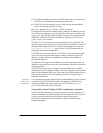
Appendix A Caching Solutions and Performance 117
For example, if a document was last modified 32 days ago and was sent to the
appliance two days ago, the document is considered fresh in cache for three
days after it was sent. (This assumes a factor of 10%.) So for this situation,
the document is considered fresh for one more day.
Because this method could result in lengthy freshness times for documents
that have not changed for long periods, cache administrators might want to
place an upper boundary on the freshness limit. With this boundary in place
the freshness limit becomes the smaller of the two values: the boundary or the
computed freshness limit. For information on how to configure an upper
boundary, refer to the Freshness section of the Configure: Cache page of the
Manager UI. See Freshness‚ on page 36.
Default test:
For documents that do not have Expires headers or do not have both Last-
Modified
and Date headers, you can specify an absolute freshness limit in
the Freshness section of the Configure: Cache page. See Freshness‚ on
page 36.
Revalidate rules:
Revalidate rules apply specific freshness limits to specific HTTP or FTP
objects. From the command-line interface, you can set freshness limits for
objects originating from particular domains or IP addresses, objects with
URL addresses that contain specified regular expressions, and objects
requested by particular clients. See Configuring caching rules‚ on page 79.
Deciding whether to serve HTTP objects
Even though a document might be fresh in the cache, clients or servers could
have constraints that prevent them from retrieving the document from the cache.
For example, a client might request that a document not come from a cache, or if
it does, the document cannot have been cached for more than 10 minutes.
The Intel NetStructure Cache Appliance bases the servability of a cached
document on Cache-Control header fields. These headers can appear in both
client requests and server responses.
The following cache-control header fields affect whether objects are served:
✔ The no-cache field, sent by clients, tells the appliance to serve no objects
directly from the cache; always revalidate. You can configure the appliance to
ignore client no-cache fields. See Cache activation‚ on page 35.
✔ The max-age field, sent by servers, is compared to the document age; if the
age is less than the max-age, the document is fresh and can be served.


















